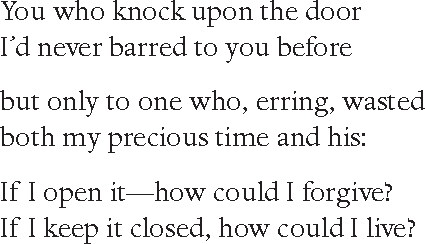SHELOMO IBN TZAQBEL
(first half of the twelfth century)
Rhymed prose had long existed in both Arabic and Hebrew literature, albeit in wholly independent traditions. Pre-Islamic Arabic literature made use of saj‘, a nonmetrical mode that was employed by soothsayers and diviners for their incantations, and numerous parts of the Quran are also composed in a musical and powerfully cadenced prose employing variable rhyme. In the Hebrew tradition, liturgical poetry from Byzantine Palestine often contained passages of nonmetrical rhymed prose; the mid-eleventh-century Italian Byzantine historical chronicle Megillat HaYuhasin (or Megillat Ahima’atz) for example, employs rhymed prose throughout; and of course Ibn Gabirol’s great poem Keter Malkhut makes magnificent use of saj‘. It was only at the end of the tenth century, however, that the term maqaama was introduced into Arabic and that the literary genre of the rhymed-prose narrative took shape in its fictional mode, with a standard set of conventions that usually included a wandering narrator representing a given set of social ideals; a literarily gifted, mischievous, and socially marginal protagonist—often one who had fallen from grace and was almost always an itinerant beggar; and a loosely strung together recounting of the pair’s adventures and the complex relation between them. In many ways the maqaama might be considered the forerunner of the picaresque novel. The term itself derives from the Arabic word for “place” (maqaam)—as in “place of assembly” or public gathering. In later Hebrew the maqaama is distinguished by its new narrative content, its artful literary style, its entertainment value, and the insertion of metrical lyric poems into the flow of the narrative itself. These poems, which are almost always in the classical monorhymed Andalusian style, serve to intensify a given element of the narrative and enhance its hero’s standing by a display of his literary powers. Schirmann likens them to arias in an opera. In addition to their intensifying and illustrative functions, they provide pleasure on both the narrative and linguistic level.
SHELOMO IBN TZAQBEL is the author of the first Hebrew maqaama, Mahberet Ne’um Asher Ben Yehuda (The Book of Asher Ben Yehuda). This short tale, which is considered among the finest of its kind, tells of the bizarre experiences of its eponymous hero in his friend’s harem. Courtship and notions of the cooked and the raw; desire, terror, titillation, and cross-dressing—all come together in this at-once realistic and fanciful story. Nothing is known about its author, apart from the fact that he lived in Muslim Spain and wrote this maqaama along with one other (only fragments of which remain). The poems that follow are taken from various points in the narrative, as the hero is gradually drawn into the harem and toward the mysterious woman who, as the story opens, throws him an apple with a poem written across its skin.

LINES INSCRIBED ON AN APPLE

NOTE TO A SUITOR NOW PERPLEXED

A FAWN WITH HER LASHES
